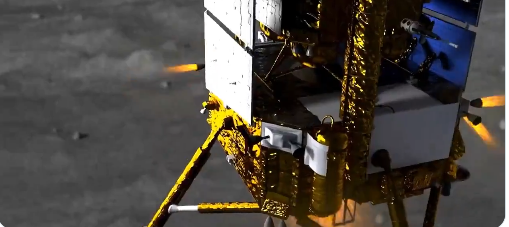China is pushing ahead of the United States, thanks to all of their stolen tech from America. They continue to take secrets weekly from our top universities and firms. The Biden Administration does nothing about it all, and in face they had the FBI stop investigating many crimes taking place, allowing China to steal at will. So, China is becoming a space power…
In an unprecedented space endeavor, China’s Chang’e 6 mission successfully returned to Earth with rock and soil samples from the moon’s far side, a region previously unexplored by human-made probes. The spacecraft touched down in the Inner Mongolia region of northern China on a recent Tuesday afternoon, marking a significant milestone in lunar exploration.
NEW:
🇨🇳 China becomes the first country to retrieve lunar samples from the far side of the moon
Chang’e-6 landed safely on earth earlier today, after collecting samples on the moon in a mission that lasted 53 days. pic.twitter.com/7Vh1MAbe9m
— Megatron (@Megatron_ron) June 25, 2024
This mission distinguishes itself as the first to retrieve samples from the moon’s far side, unlike previous American and Soviet missions which collected materials from the more familiar near side. The samples, believed to be around 2.5 million years old, likely contain volcanic rock and other substances. Scientists are keen to study these materials to understand the disparities between the lunar hemispheres.
The far side of the moon, always hidden from Earth’s view, presents unique challenges for exploration. It lacks direct communication with Earth, necessitating the use of a satellite to relay signals. A Chinese satellite, stationed in lunar orbit since March, played a crucial role in maintaining communication with the Chang’e 6 probe during its mission.
China becomes the first country to retrieve lunar samples from the far side of the moon!
Chang’e-6 landed safely on earth earlier today.
Quite a breathtaking tech achievement! 👍👍
— S.L. Kanthan (@Kanthan2030) June 25, 2024
The far side’s landscape is rugged, characterized by mountains and craters, contrasting sharply with the smoother plains of the near side. These characteristics make the far side a rich ground for uncovering new geological information, potentially offering insights into the solar system’s formation and the moon’s meteoritic history.
Launched on May 3 from the Wenchang Space Launch Site on Hainan Island, the Chang’e 6 embarked on its journey, eventually landing in the expansive South Pole-Aitken basin, a large and ancient impact crater. The mission, spanning 53 days, represents a leap forward in China’s burgeoning space program.
Post-mission, the probe and its precious cargo were transported to Beijing for detailed analysis. Scientists, including Zongyu Yue from the Chinese Academy of Sciences, expressed high expectations for the samples to reveal the geological processes that have shaped the differing lunar landscapes. These findings were discussed in “The Innovation,” a journal associated with the Chinese Academy of Sciences.
A video review of the entire Chang’e-6 mission and details of the return capsule. pic.twitter.com/9yRaMY71eT
— Shanliren (@wlmphi) June 25, 2024
China’s aggressive pursuit of lunar exploration has seen significant strides in the past decade. Following its initial moon landing in 2013 with the Chang’e 3 mission, China achieved another first in 2019 by landing Chang’e 4 on the lunar far side, deploying the Yutu-2 rover to explore the Von Kármán crater. In 2020, the Chang’e 5 mission returned samples from the Oceanus Procellarum, a volcanic region on the near side.
With plans to send astronauts to the moon by 2030 and aspirations to establish a lunar base, China’s advancements fuel a competitive spirit among global powers, each vying to expand their presence in space and unveil the moon’s hidden secrets.
Major Points
- China’s Chang’e 6 probe successfully returned to Earth with samples from the moon’s far side, marking a historic first in lunar exploration.
- The spacecraft landed in Inner Mongolia and brought back samples likely containing ancient volcanic rock.
- This mission is the first to collect materials from the far side of the moon, which is not visible from Earth and presents significant communication challenges.
- The samples are expected to provide insights into the geological differences between the moon’s two sides and the solar system’s formation.
- The mission underscores China’s growing capabilities in space exploration, with plans for future manned missions and a potential lunar base.
Fallon Jacobson – Reprinted with permission of Whatfinger News



